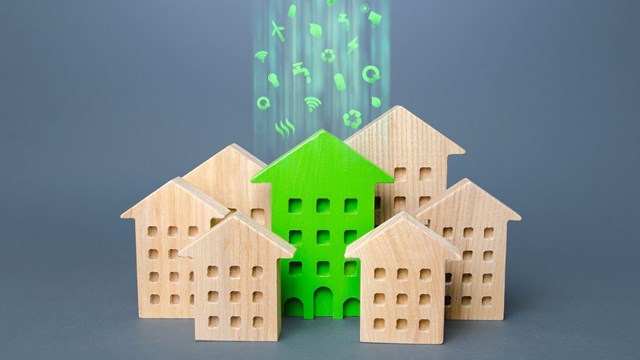Multifamily buildings—both new and existing—face barriers to decarbonization amid competing demands and growing pressure from legislation, residents, and tenants. But there are opportunities to build value today, namely energy efficiency and strategic electrification, while making progress toward a decarbonized future.
New York’s emissions reduction targets are guided by the Climate Act, with building energy efficiency and electrification serving as a cornerstone for the State’s climate goals.
Decarbonization of new buildings was codified in 2023. Starting in 2026, the installation of fossil fuel equipment is prohibited in new buildings up to seven stories before applying to all new construction in 2029 (barring exceptions for certain commercial and emergency uses). New York City’s Local Law 154 and other municipal legislation set even earlier timelines for all-electric new construction.
Other policies, including Local Law 97, aim to accelerate decarbonization in existing buildings. Thus, now is the opportune time for property owners and condo and co-op boards to begin planning their decarbonization strategy—both to futureproof against regulation and the increasing risks climate change poses to their assets.
A Phased & Tailored Approach
Retrofitting existing buildings and converting to all-electric equipment requires considerable planning and investment. However, it is not an all-or-nothing proposition, and the reality is that many multifamily buildings will take a phased approach.
While full electrification is the end goal of decarbonization for most building types, reducing energy use with efficiency improvements and partial electrification can be a cost-effective bridge solution to begin transitioning away from fossil fuels. It’s important to factor in the design and remaining useful life of building systems when determining the most appropriate approach to partial or full electrification.
The International Tailoring Co. Building in Manhattan, for instance, repurposed its existing hydronic loop system to integrate nine central air-to-water heat pumps and two new condensing boilers. The retrofit project also utilizes waste heat in the summer for hot water and a web-based building management system to optimize efficiency.
The 13-story co-op expects 38% energy usage savings from the heating and cooling systems alone, plus additional savings from the building management system and smart thermostats. “This is the right technology for us, no matter what, even without any of the climate laws,” notes co-op board president Eric Einstein.
Developing a Decarbonization Strategy
Not having a plan for building decarbonization will soon become a liability for condo and co-op boards. Taking stock of building systems and energy performance is a fundamental first step to compare options and prioritize investments. Multifamily facilities can access technical assistance to help inform their decarbonization strategy.
The best path for energy efficiency, electrifying building systems, and incorporating renewables will depend in part on the building design, useful life of assets, and lease structure (if applicable). Factoring in clean energy tax credits from the Inflation Reduction Act, plus New York State incentives, is important to determine the return on investment and financing needs associated with any decarbonization strategy.
All-Electric is Feasible Today
Efficient, all-electric technologies are already available for multifamily buildings and most commercial applications. Notably, the number of heat pumps sold in the U.S. surpassed gas furnace sales for a second consecutive year. Cold-climate heat pumps are used in most buildings in Norway and Sweden, underpinning their efficacy across New York State.
Though work is still underway to connect more renewables to the grid, replacing a fossil fuel heating system with heat pumps in New York, today, could reduce a building’s emissions by 41% in the first year of installation.
Village Grove, a 40-unit affordable multifamily building in Tompkins County, showcases decarbonized new construction with its efficient, all-electric systems, including ground source heat pumps, and Passive House design. To offset the building’s annual energy consumption, the property is purchasing electricity from an off-site community solar project.
Innovation and technological advances will continue to make decarbonization an easier and cost-effective proposition. Through the Clean Heat for All Challenge, appliance manufacturers are designing and testing efficient window heat pump units —a potential decarbonization solution that could bypass more costly multifamily building retrofits.
Thermal energy networks, also known as community heat pumps, are another approach to decarbonizing heating and cooling on a larger scale that is being evaluated by municipalities, colleges, and larger properties across New York. Such systems use a network of pipes to connect multiple buildings and distribute thermal energy through geothermal processes, surface water, or recirculating waste heat.
Building for a Decarbonized Future
While new technologies will be required to decarbonize certain industrial uses that require high temperature heat, there’s ample opportunity now for curbing emissions and energy use across all building types.
Through a combined approach of reducing energy loads, recovering wasted heat, and integrating renewables, moving towards partial or full electrification is technologically feasible today. This phased strategy is also fundamental to its cost-effectiveness, as greater operating efficiencies minimize the system sizing requirements and total investment to retrofit multifamily buildings for a decarbonized future.
The New York State Energy Research and Development Authority (NYSERDA) can connect multifamily developers, property owners, and condo and co-op boards with technical experts and resources to take the guesswork out of decarbonization. Find out more at nyserda.gov.










Leave a Comment